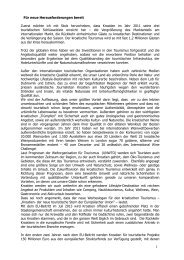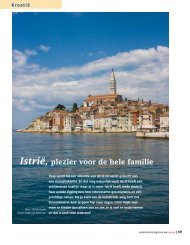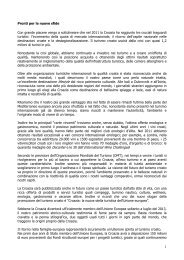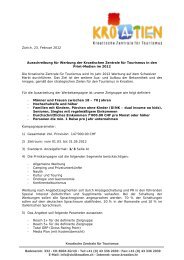Create successful ePaper yourself
Turn your PDF publications into a flip-book with our unique Google optimized e-Paper software.
PRESS <strong>2011</strong><br />
of the city, from Byzantines to the Venetians, Ottomans and Austria.<br />
For four hundred long years it was an independent commune under<br />
Venetian rule and during this time the most significant landmarks<br />
were created. Today one of them is a symbol of the city and a<br />
monument under the protection of UNESCO, the cathedral of St.<br />
Jakov - a masterpiece of Juraj Dalmatinac from the 15 th century. It<br />
was built during a period of 105 years solely from stone from the<br />
islands of Brač, Rab and Korčula and represents the only building in<br />
Europe built by a principle of sloted in stone plates with no connective<br />
material between them. The Cathedral is unique among Renaissance<br />
churches because of the facade in the shape of a trefoil and a series<br />
of 71 realistic portraits on the apses.<br />
The famous architect Juraj Dalmatinac also supervised the<br />
construction of the well known Šibenik wells that are today the stage<br />
for various cultural and entertainment events. Šibenik also boasts<br />
the richness of religious buildings, as there were 24 churches and six<br />
monasteries built in the tenth century. Today, only half are still in use,<br />
while others have been converted into museums, galleries, art and<br />
living spaces. On the central Square of the Republic of Croatia are<br />
valuable historical buildings - the City Hall and the Rector’s Palace.<br />
Among the important buildings in the heart of the city is the Šibenik<br />
Theatre, built in 1870.<br />
In the vicinity of Šibenik are Vodice, a town well known for its lively<br />
tourist attractions, entertainment and friendly locals, who welcome<br />
guests as dear friends. Although known as a destination for guests<br />
looking for fun, the natural peace of the beaches in Vodice and quiet<br />
coves provide each guest with a well-deserved vacation.<br />
The Kornati archipelago spreads over an area of about 320 km² and<br />
includes about 150 small and large islands and reefs, of which 89<br />
are a part of the National Park Kornati. Here the sea is especially<br />
blue, and the vertical cliffs dive headlong into its depths from a few<br />
hundred meters. The charm of secluded bays leaves every lover of<br />
the sea breathless. The archipelago was named after the largest<br />
island Kornat. The center of life on this island used to be around the<br />
field Tarac, dominated by the fortress Tureta, built in the 6 th century.<br />
Located there is the Church of Our Lady of Tarac, the Queen of the Sea<br />
built on the ruins of an early Christian church from the 16 th century.<br />
Believers from the island of Murter each year, on the first Sunday in July,<br />
have a pilgrimage to Our Lady of Tarac, and the covenant procession of<br />
boats is one of the most beautiful religious events in Croatia. Although<br />
the Kornati archipelago is not permanently inhabited, a few laborer’s<br />
and fisherman’s houses are scattered around the picturesque bays<br />
of Žut, Sita and Kornati and the islands reflect the presence of their<br />
respective owners. Today, these houses are converted into restaurants<br />
and accommodation for ‘Robinson’ tourism and have become a favorite<br />
destination for boaters and tourists.<br />
The National Park Krka, the realm of the wondrous karst beauty -<br />
River Krka, which passes through canyons two thirds of its way to the<br />
sea, represents the complete opposite to Kornati. On this green path<br />
it spills over seven waterfalls one of which the last one is Skradinski<br />
Buk. The park is inhabited by 222 species of birds which puts it among<br />
the most valuable bird areas in Europe. It can be visited by boat, car<br />
or on foot. Also unavoidable is the ethno-museum in one of the<br />
old mills. In the area of the National Park Krka is the only falconry<br />
center in Croatia, where during the tour you can see presentations<br />
of hunting with falcons and demonstrations of falcon skills. The Krka<br />
National Park hides in its bosom two distinct historical and cultural<br />
pearls – the Orthodox Monastery of St. Archangel Krk and the<br />
fairytale monastery Visovac where Franciscans have kept valuables,<br />
old paintings and art, since 1400. The area around Krka is rich in ruins<br />
of antique settlements and prehistoric sites, as well as the remains of<br />
a Roman aqueduct, which is a protected monument.<br />
Cultural and Natural Richness<br />
Cultural and historical monuments still bear witness to the long<br />
settlement and architectural capabilities of the population of the<br />
region. In this area there are as many as 12 medieval fortresses, 230<br />
monuments and 600 archaeological sites. Particularly interesting are<br />
the ancient sites of Bribirska glavica, the Roman Skardona and four<br />
fortifications of Šibenik - St. Mihovil, St.Ivan, Šubićevac and St. Nikola.<br />
Also of great importance for tourism is the fortress of Knin, which was<br />
occasionally the seat of Croatian kings.<br />
Bribirska glavica was named the Croatian Troy with good reason<br />
because of the mystical combination of nature and ancient structures.<br />
Due to its strategic position for a full six thousand years it was the<br />
central town of the entire region. All civilizations recognized the<br />
importance of this old Liburnian settlement, the Roman municipality<br />
of Varvaria, by which Bribir was named. The mythical Bribir was the<br />
seat of the powerful Croatian feudal ruler Ban Pavao Šubic Bribir.<br />
Primošten has the richest and most picturesque vineyards in the<br />
entire region that speak of human diligence and struggle in this<br />
sparse area. In 2009 they were introduced as the UNESCO candidate<br />
for the list of protected world cultural heritage, and their image is<br />
permanently placed in the main United Nations building in New<br />
York, representing the sorrows of human labor through the centuries<br />
and the struggle of people with Dalmatian stone. Produced from the<br />
grapes from the vineyards of Primošten is the famous wine Babić,<br />
one of the best Croatian red wines. Another gastronomic souvenir<br />
of the Šibenik area is the Drniš ‘pršut’ (dried ham) whose quality is<br />
recognized throughout the world. Among the Šibenik sights we can<br />
set aside the Nature Park Vransko Lake, which is a unique swamp<br />
terrain in our coastal areas. This area is of international importance<br />
as a resting and feeding place for migratory birds. As many as 140<br />
bird species from Central, Northern and Eastern Europe use this area<br />
as part of their migration route.<br />
73
















